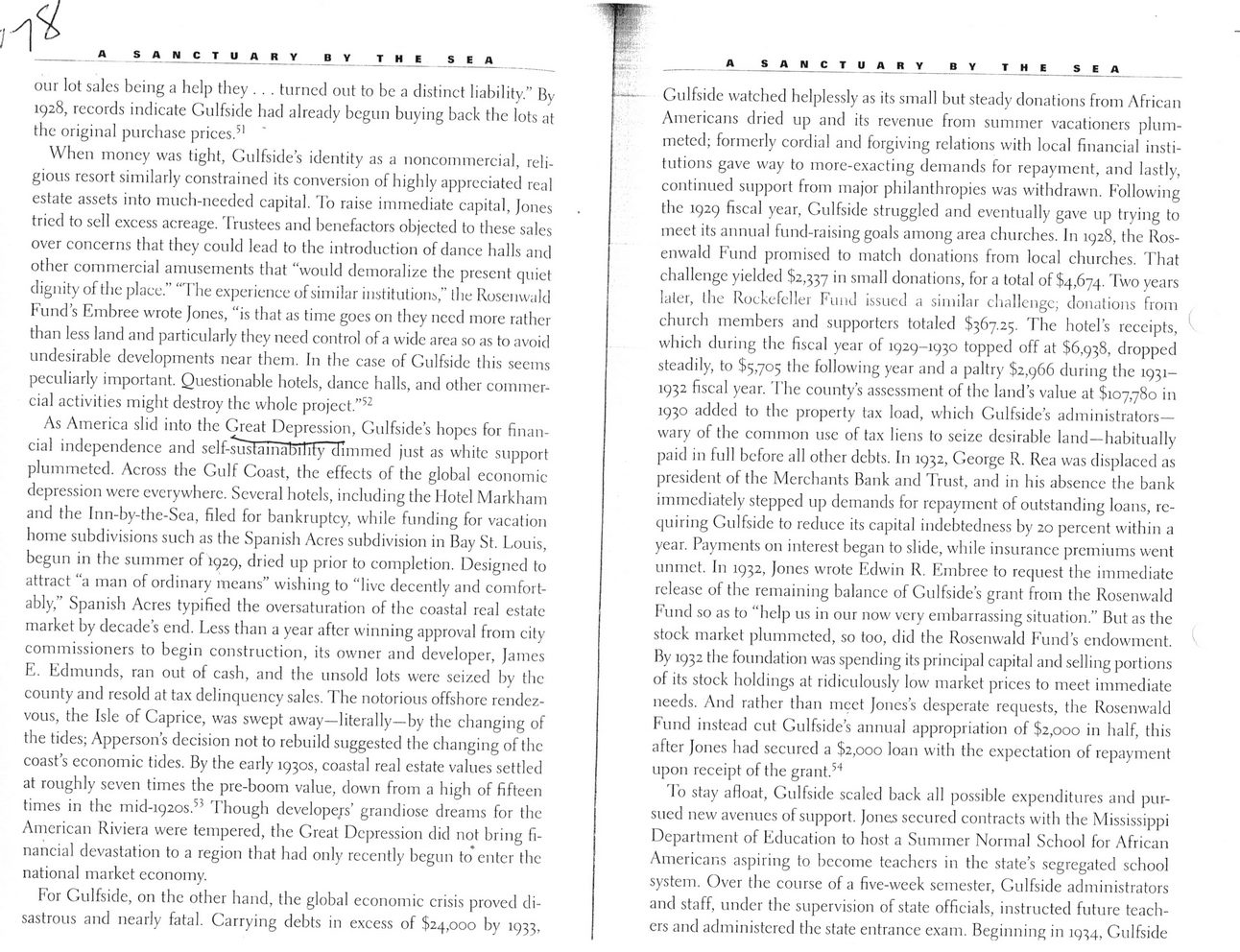This text was obtained via automated optical character recognition.
It has not been edited and may therefore contain several errors.
_____A SANCTUARY BY THE SEA_________________________________ our lot sales being a help they . . . turned out to be a distinct liability.” Bv 1928, records indicate Gulfside had already begun buying back the lots at the original purchase prices.51 When money was tight, Gulfside’s identity as a noncommercial, religious resort similarly constrained its conversion of highly appreciated real estate assets into much-needed capital. To raise immediate capital, Jones tried to sell excess acreage. Trustees and benefactors objected to these sales over concerns that they could lead to the introduction of dance halls and other commercial amusements that “would demoralize the present quiet dignity of the place.” "The experience of similar institutions,” I he Rosenvvald Fund’s Embree wrote Jones, “is that as time goes on they need more rather than less land and particularly they need control of a wide area so as to avoid undesirable developments near them. In the case of Gulfside this seems peculiarly important. Questionable hotels, dance halls, and other commercial activities might destroy the whole project.”52 As America slid into the Great Depression, Gulfside’s hopes for financial independence and self-suslainabilily dimmed just as white support plummeted. Across the Gulf Coast, the effects of the global economic depression were everywhere. Several hotels, including the Hotel Markham and the Inn-by-the-Sea, filed for bankruptcy, while funding for vacation home subdivisions such as the Spanish Acres subdivision in Bay St. Louis, begun in the summer of 1929, dried up prior to completion. Designed to attract “a man of ordinary means” wishing to “live decently and comfortably,” Spanish Acres typified the oversaturation of the coastal real estate market by decade’s end. Less than a year after winning approval from city commissioners to begin construction, its owner and developer, James E. Edmunds, ran out of cash, and the unsold lots were seized by the county and resold at tax delinquency sales. The notorious offshore rendezvous, the Isle of Caprice, was swept away—literally—by the changing of the tides; Apperson’s decision not to rebuild suggested the changing of the coast’s economic tides. By the early 1930s, coastal real estate values settled at roughly seven times the pre-boom value, down from a high of fifteen times in the mid-ig20s.53 Though developers’ grandiose dreams for the American Riviera were tempered, the Great Depression did not bring financial devastation to a region that had only recently begun to enter the national market economy. For Gulfside, on the other hand, the global economic crisis proved disastrous and nearly fatal. Carrying debts in excess of $24,000 by 1933, A SANCTUARY BY THE SEA Gulfside watched helplessly as its small but steady donations from African Americans dried up and its revenue from summer vacationers plummeted; formerly cordial and forgiving relations with local financial institutions gave way to more-exacting demands for repayment, and lastly, continued support from major philanthropies was withdrawn. Following the 1929 fiscal year, Gulfside struggled and eventually gave up trying to meet its annual fund-raising goals among area churches. In 1928, the Ros-enwald Fund promised to match donations from local churches. That challenge yielded $2,337 in small donations, for a total of $4,674. Two years laler, the Rockefeller Fund issued a similar challenge; donations from church members and supporters totaled $367.25. The hotel’s receipts, which during the fiscal year of 1929-1930 topped off at $6,938, dropped steadily, to $5,705 the following year and a paltry $2,966 during the 1931— 1932 fiscal year. The county’s assessment of the land’s value at $107,780 in 1930 added to the property tax load, which Gulfside’s administrators— wary of the common use of tax liens to seize desirable land—habitually paid in full before all other debts. In 1932, George R. Rea was displaced as president of the Merchants Bank and Trust, and in his absence the bank immediately stepped up demands for repayment of outstanding loans, requiring Gulfside to reduce its capital indebtedness by 20 percent within a year. Payments on interest began to slide, while insurance premiums went unmet. In 1932, Jones wrote Edwin R. Embree to request the immediate release of the remaining balance of Gulfside’s grant from the Rosenwald Fund so as to “help us in our now very embarrassing situation.” But as the stock market plummeted, so too, did the Rosenwald Fund’s endowment. By 1932 the foundation was spending its principal capital and selling portions of its stock holdings at ridiculously low market prices to meet immediate needs. And rather than meet Jones’s desperate requests, the Rosenwald Fund instead cut Gulfside’s annual appropriation of $2,000 in half, this after Jones had secured a $2,000 loan with the expectation of repayment upon receipt of the grant.54 To stay afloat, Gulfside scaled back all possible expenditures and pursued new avenues of support. Jones secured contracts with the Mississippi Department of Education to host a Summer Normal School for African Americans aspiring to bccome teachers in the state’s segregated school system. Over the course of a five-week semester, Gulfside administrators and staff, under the supervision of state officials, instructed future teachers and administered the state entrance exam. Beginning in 1934, Gulfside

Gulfside Methodist Assembly Land-was-Ours---book-Kahrl-(11)